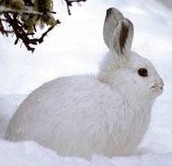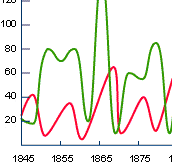 |
This hare breeds at one year of age and can have as many as four litters in a season when food is plentiful. Population density exhibits extreme fluctuations, and can range from 1 to 10,000 per square mile across the species range.
They are a dominant herbivore and eat a variety of vegetation. Feeding on bark of young trees when the population is abundant, they can be responsible for considerable damage. Overbrowsing leads to malnourishment, adversely affecting reproduction which may begin the crash.
 |
Lynx pelts are an important source of income in the northwest part of their range. However, the lynx population suffers a dramatic decline after the snowshoe hare population crashes. The additional mortality from commercial trapping at low lynx densities delays a rapid recovery of the lynx population in response to the growing hare population.
Lepus americanus (snowshoe hare)
Lynx-Snow Hare Cycle in Canada
What Drives the 10-year Cycle of Snowshoe Hares?